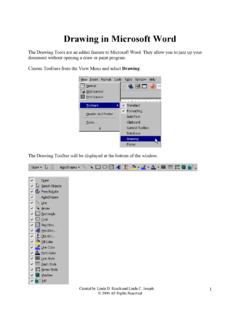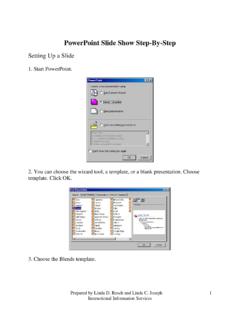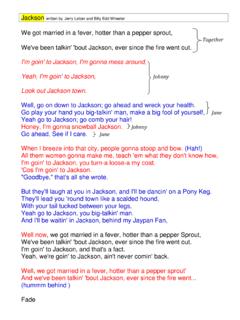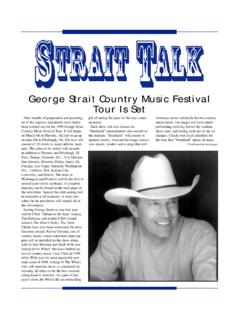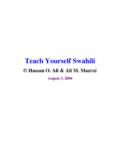Transcription of Copyright Lesson Plan by Laura Kaemming
1 Copyright Lesson plan by Laura Kaemming Topic: Copyright Laws Grade Level: Eighth Grade Objectives: 1. Students will be introduced to and develop a basic understanding of Copyright laws. 2. Students will identify examples of Copyright infringement. Materials: Music Alive magazine (December 2000 issue); musical excerpts from: Ice, Ice Baby as performed by Vanilla Ice, Under Pressure as performed by Queen, My Sweet Lord as performed by George Harrison, He's So Fine as performed by The Chiffons, I Want a New Drug as performed by Huey Lewis and the News, Ghostbusters as performed by Pay Parker, Jr.; Checklist for Fair Use from , overheads, Copyright and You Be the Judge worksheets, written test.
2 Procedure: Day One Students should answer pre-reading questions on Copyright worksheet - then discuss answers with classmates Students will read aloud the article entitled, Music as Intellectual Property . What's at Stake? from the December 2000 issue of Music Alive magazine. (Students should answer remaining questions on Copyright worksheet.). Day Two Students should share and discuss answers from Copyright worksheet Discuss Copyright rules/regulations and fair use with students (Students should take notes based on presentation and overhead transparencies.). Day Three Review Copyright rules and regulations As a group - listen to/compare/discuss excerpts from the songs Ice, Ice Baby and Under Pressure.
3 Read/answer You Be the Judge worksheet while listening to musical excerpts (replay examples as needed). continued on page two 3. 2001, LKVTSSP. Day Four Review fair use policy Discuss answers for You Be the Judge worksheet Oral Discussion: Do you know of any other Copyright cases in the field of music? What about in the movie industry? Elsewhere? . Evaluation: Students will achieve both objectives through discussions and written assessments. Students must correctly answer at least 70% of items on graded worksheets and tests to receive a passing grade. 2001, LKVTSSP. Copyright Copyright happens automatically as soon as a copy of the work is created.
4 Just because you don't see the Copyright symbol doesn't mean the work is public domain (you have the right to use it freely). In fact, the opposite is usually true. The symbol itself can provide the reader with important information including who owns the Copyright and the first year of publication. A person does not have to register their work with the Copyright Office for action to be taken against a person infringing on that work; however it will help. Copyright registration is a public record and puts other people on notice. The Copyright owner has the exclusive rights to: reproduce the work prepare spin off created from the work distribute copies or phonorecords (cassette tapes, CD's LP's, 45 rpm's as well as other formats) by sale or transfer of ownership, rental, lease or lending perform the work publicly (for plays, musicals, poetry, choreography, pantomimes, movies and other audiovisuals).
5 Display the work publicly (poems, musicals, plays, choreography, pantomimes, pictorial, graphics, sculptures, individual images from movies and other audiovisual works). perform publicly (by digital audio transmission) sound recordings They can also give permission for others to do the same. Copyrights can be obtained for the following types of works: & Literary (including computer programs). Musical (including accompanying lyrics ). Dramatic (including accompanying music). P Pantomimes and choreographic - Pictorial, graphic and sculpted (including maps). Motion picture and other audiovisual Sound recordings H Architectural 2001, LKVTSSP. Registration: Registering a work is a simple process.
6 Send the following three items together in the same envelope. 1. A completed application form. (This can be found on the Copyright Office Website at ). 2. A $30 non-refundable filing fee (effective through 6-30-02) for each application. 3. A non-returnable copy of the work to be registered. All three items MUST be sent in the same package! Just because your work is copyrighted in the does not mean it is throughout the world. Most countries offer some protection to foreign works under certain conditions. If you would like to see which countries maintain Copyright relations with the visit the Copyright Office Website mentioned above. Length: Once you have obtained Copyright protection, how long will it be safe?
7 Currently once a work is created it is protected until 70 years after the author has died. If there are co-authors, the Copyright lasts until 70 years after the last surviving author passes away. For works that were commissioned and those written under pseudonyms or whose authors are unknown, the Copyright is effective 95 years from first publication or 120. years from creation whichever is shortest. The author can sell their copyrights to another party (as was the case of Michael Jackson purchasing a large number of Beatles songs) and can even leave them to someone in their will. 2001, LKVTSSP. Fair Use If a person wishes to use part of someone else's work they have to obtain written permission from the author of that original work.
8 Only in fair use cases do you not have to obtain this. The courts created fair use guidelines for teachers and students. This policy permits those of us working in the school setting to borrow parts of an original work without obtaining written permission from the author. There are four basic guidelines used for the fair use policy - purpose, nature, amount and effect. The Copyright Management Center at Indiana University has a great checklist for fair use. You can view this whole document by going to their website at Below are some of the acceptable and unacceptable uses mentioned on this site. Purpose Nature Amount Effect Acceptable Acceptable Acceptable Acceptable Teaching, research, Factual, important Small quantity, No major effect on news reporting to education portion is not crucial the market, user to entire work legally owns a copy of original work Illegal Illegal Illegal Illegal Making money from Very creative work Large or entire work Could replace sale of work, don't (art, music, literary, used, the part of the selling of original, give credit to author films, plays)
9 , fiction original used is many copies made, of original work crucial to new used for a long time, work's success made it available on the Web United States Government works are considered public domain and may be used freely. 2001, LKVTSSP. Generally speaking up to 10% of a work can be used. See the chart below for more clarification. Motion Media Text Material Music, lyrics Illustrations and and Music Video Photographs Up to 10% or 3 Up to 10% or 1000 Up to 10% but no An entire photo or minutes, whichever words, whichever is more than 30 drawing may be is less less; an entire poem seconds of the used but no more of less than 250 music and lyrics , than 5 images from words may be used alterations to a the same artist, or but no more than 3 musical work can't when from a excerpts from a poet change the basic published collective melody or character work not more than of work 10% or 15 images, whichever is less 2001, LKVTSSP.
10 Copyright Worksheet Name _____Class _____ Date _____. DIRECTIONS: Answer the following questions. Pre-Reading: 1. Have you ever visited a web site such as Napster? _____. 2. Have you ever downloaded a song from one of these sites? _____. 3. If you did, did you ever buy the CD that particular song was on? _____. 4. Do you think people should be allowed to copy items such as songs, and movies without paying for them? Why? Explain your answer. _____. _____. 5. Do you own a CD burner? _____. 6. Have you ever copied a song onto a CD or cassette?_____. 7. What does the symbol mean ? _____. Read the magazine article (pages 10-11) from the December 2000 Issue of Music Alive.
